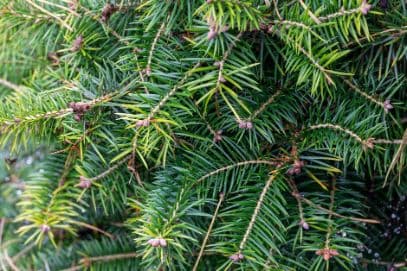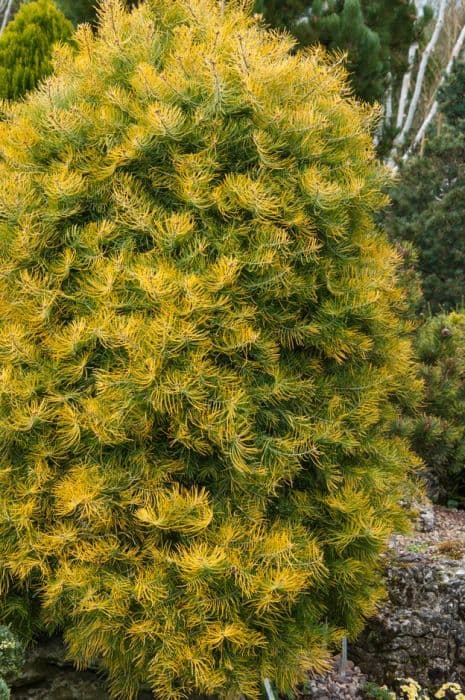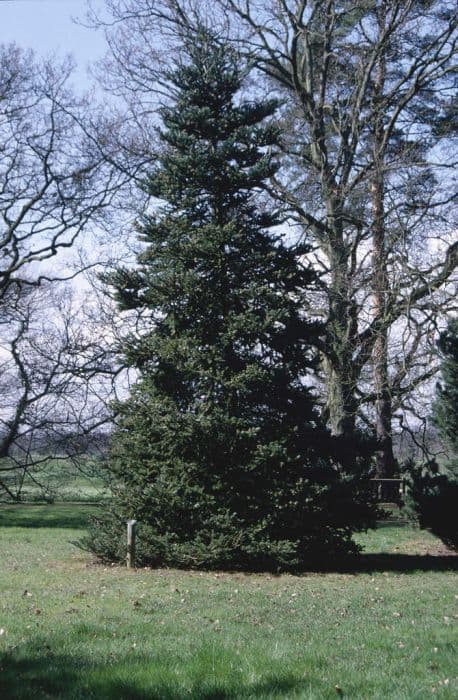Jack pine Pinus banksiana

ABOUT
The Jack Pine is a coniferous tree recognized by its unique and somewhat irregular shape. Its bark is rough and dark, often appearing reddish-brown, which flakes off in small scales. The needles are slender, sharp, and come in bundles of two, possessing a blue-green to yellow-green color. These needles are relatively short in comparison to those of other pine species. The branches grow erratically, giving the tree a somewhat twisted and rugged look, contributing to its distinctive appearance. The cones of the Jack Pine are particularly noteworthy. They are curved and remain tightly closed, and often require the heat from a fire or exposure to intense sunlight to open, a strategy for seed dispersal. Moreover, the appearance of Jack Pine cones can vary, but they generally present themselves with a small and conical shape. They are often serotinous, meaning they stay unopened until exposed to the high temperatures from wildfires, emphasizing their adaptation to their natural environment. Overall, the Jack Pine can be characterized by its rough, flaky bark, short, sharp needles grouped in pairs, twisted branch structure, and small, sturdy, curved cones that rely on high temperatures to release their seeds. This gives the Jack Pine a rugged and distinctive look among the coniferous trees.
About this plant
 Names
NamesSynonyms
Jack Pine, Grey Pine, Scrub Pine, Banksian Pine, Black Pine, Hudson Bay Pine, Northern Scrub Pine
Common names
Pinus divaricata, Pinus hudsonica, Pinus sylvestris var. banksiana, Pinus banksiana var. hudsonica, Pinus rupestris, Pinus clausa.
 Toxicity
ToxicityTo humans
The common name for Pinus banksiana is Jack pine. Jack pine is not typically known to be toxic to humans. There is no widespread documentation to suggest that ingesting parts of the Jack pine, such as needles, bark, or sap, typically leads to poisoning or significant adverse health effects in humans.
To pets
As for Jack pine's toxicity to pets, it is not generally considered poisonous to animals. However, the ingestion of plant material such as pine needles can potentially lead to mild gastrointestinal irritation or discomfort due to the physical nature of the needles. Common symptoms could include vomiting or diarrhea if a pet consumes a significant quantity. But the Jack pine itself does not contain toxic compounds known to cause severe poisoning in pets.
 Characteristics
CharacteristicsLife cycle
Perennials
Foliage type
Evergreen
Color of leaves
Green
Height
20-80 feet (6-24 meters)
Spread
10-20 feet (3-6 meters)
Plant type
Tree
Hardiness zones
2
Native area
North America
Benefits
 General Benefits
General Benefits- Erosion Control: Pinus banksiana, known as Jack pine, has a root system that helps stabilize soil, preventing erosion.
- Habitat: It provides shelter and nesting sites for various species of wildlife, including birds and small mammals.
- Economic Value: Wood from Jack pine is used in construction, for making pulpwood, and as biomass for fuel.
- Aesthetic Appeal: Jack pine is often used in landscaping for its unique, often twisted appearance and ability to grow in a variety of conditions.
- Reforestation: It is commonly used in reforestation projects due to its adaptability to poor soil conditions and its ability to repopulate quickly after disturbances like fire.
- Climate Resilience: As a species native to North America, Jack pine is well adapted to local climates and can withstand harsh conditions, including drought and cold temperatures.
- Food Source: The seeds of Jack pine are consumed by various birds and small animals, playing a part in the food chain.
 Medical Properties
Medical Properties- Pinus banksiana, commonly known as Jack pine, traditionally has not been widely recognized for its medicinal properties and there is limited documented evidence to support specific medicinal uses.
- This plant is not used for medical purposes.
 Air-purifying Qualities
Air-purifying QualitiesThis plant is not specifically known for air purifying qualities.
 Other Uses
Other Uses- Jack Pine resin is sometimes used in the manufacturing of turpentine, which is a solvent for paints and varnishes.
- The cones of the Jack Pine can be utilized in crafts and decorations, often being painted or incorporated into wreaths and ornaments.
- Wood from the Jack Pine is sometimes used to make crates and pallets, given its availability and relative strength.
- The bark of the Jack Pine can serve as mulch for gardening, helping to retain soil moisture and regulate temperature.
- The tree has been used traditionally to create snow fences, which are barriers that cause snow to accumulate in a desired area.
- In landscaping, the Jack Pine can be planted for erosion control due to its ability to thrive in poor soil conditions.
- The knotty appearance of Jack Pine wood is sometimes prized for rustic furniture-making and interior paneling.
- Jack Pines can be used as Christmas trees, especially in regions where they are abundantly found.
- The tree's roots can stabilize sand dunes, thereby protecting coastlines and preventing sand drift.
- Jack Pine wood shavings have been employed as bedding material for small animals in farms or households.
Interesting Facts
 Feng Shui
Feng ShuiThe Jack Pine is not used in Feng Shui practice.
 Zodiac Sign Compitability
Zodiac Sign CompitabilityThe Jack Pine is not used in astrology practice.
 Plant Symbolism
Plant Symbolism- Resilience: Pinus banksiana, commonly known as Jack Pine, is known for its ability to thrive in poor soil conditions and withstand fire, which makes it a symbol of resilience and the ability to endure challenging circumstances.
- Independence: The Jack Pine often grows in isolated stands and can establish itself without need for rich soils, symbolizing independence and self-reliance.
- Adaptability: With its capacity to adapt to various environments, the Jack Pine represents adaptability and the power to thrive in diverse situations.
- Regeneration: The Jack Pine's cones often require the heat of a fire to open and release seeds, representing rebirth and the cycle of regeneration after destruction.
 Water
WaterJack pine, or Pinus banksiana, requires minimal watering once established, due to its adaptation to poor, dry soils. Seedlings should be watered regularly to keep the soil moist but not waterlogged—once a week should suffice, with about a gallon per tree during each watering session. After the first year or two, watering can be reduced; during dry spells, provide mature trees with a deep watering of about two gallons once or twice a month. Always water the tree at its base, soaking the soil to reach the deep roots. Avoid overwatering as standing water can lead to root rot.
 Light
LightJack pine thrives in full sunlight, which means the plant should receive at least six hours of direct, unfiltered sunlight each day. The best spot for a Jack pine would be an area with ample open sky exposure, away from taller structures or trees that might create significant shade. They are well-adapted to sandy or rocky soils with clear overhead access to sunlight.
 Temperature
TemperatureJack pine is a hardy species that can tolerate a wide temperature range, thriving best between 60°F and 70°F. The tree can withstand minimum temperatures down into the -40°F range, making it suitable for colder climates. Maximum temperature tolerance is less well-defined, but the tree is generally heat tolerant and can survive temperatures above 80°F.
 Pruning
PruningPruning of Jack pine is typically not necessary unless to remove dead or damaged branches which can be done as needed. However, if shaping of the tree is required or there are safety concerns, pruning should be done in late winter or early spring before new growth starts. It’s best to limit pruning to removing less than one quarter of the tree's live branches in any one year to keep the tree healthy.
 Cleaning
CleaningNot needed
 Soil
SoilJack Pine, Pinus banksiana, thrives in well-draining, sandy or loamy soil with a pH ranging between 4.5 and 6.0. A mix of peat, sand, and pine bark can create an ideal growing medium. Regular checks and amendments to maintain the correct pH are recommended.
 Repotting
RepottingJack Pine should be repotted infrequently as it can be sensitive to root disturbance. Repot young trees every 2-3 years and mature pines even less frequently, only when pot-bound.
 Humidity & Misting
Humidity & MistingJack Pine prefers low to moderate humidity levels typical of its natural habitat. It can tolerate some variation but avoid excessively humid environments to prevent fungal diseases.
 Suitable locations
Suitable locationsIndoor
Jack Pine grows indoors with bright light, cool temperatures, and air circulation.
Outdoor
Place Jack Pine in full sun, cool climate, and well-draining soil.
Hardiness zone
2-6 USDA
 Life cycle
Life cycleJack pine (Pinus banksiana) begins its life cycle with seed germination, often following fire exposure which helps to open its serotinous cones and release seeds. The seedlings then establish and develop into juvenile plants, with a taproot system anchoring them and needles emerging for photosynthesis. As they mature into adult trees, Jack pines develop a thick bark to protect against fire and other environmental factors, and they form cones that are initially closed. Pollination occurs when wind disperses pollen from male cones to female cones in the spring. The fertilized female cones will take about two years to mature, within which the tree grows in height and girth. The mature cones may remain on the tree for years until a triggering event like fire causes them to open and release seeds, hence continuing the cycle.
 Propogation
PropogationPropogation time
Late winter to early spring
Jack pine, commonly known as Pinus banksiana, is best propagated through the use of seeds. The optimal time for seeding is generally in the spring, when the risk of frost has passed and the soil has begun to warm. Seeds should be collected from cones, ideally from trees that are at least 10 years old for genetic diversity and vitality. These cones typically require a period of warm stratification to mimic natural conditions, where the warmth of a fire would open the cones to release the seeds. After stratification, the seeds can be sown in well-drained soil at a shallow depth, as they require sunlight for germination. Maintaining a consistent moisture level without overwatering is crucial, as is ensuring that the young seedlings are protected from extreme elements and pests while they establish.









